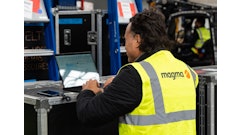
The term “automation” has been around for over 100 years but has continued to evolve over time as technology advances, enabling machines and software to take on increasingly complex tasks that once required human intervention. Over a century ago, the Industrial Revolution introduced machinery that automated countless jobs. However, in the past 20 years, we’ve begun bringing that machinery online—leveraging data to enhance efficiency and performance.
While software-driven industries have rapidly digitized, the physical world, particularly in sectors like logistics and freight, has lagged behind. By applying technology to the physical realm, we can unlock the same flexibility and adaptability that have revolutionized the digital world while enabling the workforce to focus on higher-value tasks, improve decision-making, and enhance overall efficiency, ultimately driving innovation and better service delivery in industries like logistics and supply chain management. According to Gartner’s annual CEO survey, 82% of supply chain-intensive industries plan to increase digital investment.
While technology has certainly evolved, one thing has remained constant though throughout this time, without collaboration and coordination between people, processes, and systems, even the most advanced automation cannot function effectively or drive meaningful efficiency in the supply chain. Technological collaboration is essential for optimizing operations, maximizing efficiency, and maintaining a competitive edge.
1. Advanced solutions with less time to market
Partnering with experts—whether in transportation management, warehouse automation, or real-time tracking—allows businesses and their employees to access advanced solutions without the burden of building them from scratch. By consolidating vendors and leveraging a trusted partner’s proven technology, businesses can eliminate inefficiencies, reduce integration challenges, and focus on delivering a seamless customer experience.
This approach not only accelerates time to market but also ensures access to cutting-edge innovations without the burden of continuous development and maintenance. Fewer vendors mean fewer potential points of failure, improved communication, and a more cohesive, reliable service—leading to faster, more efficient, and cost-effective solutions for customers. It also gives employees and workers the ability to focus their expertise on what exactly they were hired for whether that be technology development or customer experience.
2. Growth and enhanced customer experience
Small family-owned businesses, like cross-docks and smaller trucking fleets, can significantly benefit from leveraging the latest technology to grow their operations and enhance service quality. By adopting digital tools such as real-time tracking, route optimization software, and inventory management systems, these businesses can streamline operations, reduce costs, and increase efficiency. A report from the U.S. Chamber of Commerce showed that 81% of small businesses plan to increase their use of technology platforms.
Technology enables better communication with customers, more accurate delivery windows, and improved fleet management, allowing these businesses to compete with larger companies. Moreover, implementing automated systems for scheduling, billing, and customer service can help reduce manual errors and free up time to focus on growth. By embracing technology, small businesses can provide faster, more reliable service, build stronger customer relationships, and scale their operations in a cost-effective way.
3. Better communication and connectivity
Not every logistics company can do everything at the highest level of execution. The integration of different technologies that communicate seamlessly with each other is critical to building a more resilient supply chain. When systems such as inventory management, transportation management, and order fulfillment platforms are connected and share data in real-time, businesses gain better visibility and control over their operations. This interconnectedness allows for quicker identification of disruptions, such as delays or shortages, and enables faster decision-making to mitigate risks.
Furthermore, the ability for technologies to exchange information fosters collaboration across different stakeholders—suppliers, distributors, and logistics providers—ensuring that all parties are aligned and can respond swiftly to changes in demand or unforeseen events. Ultimately, this level of technological coordination enhances agility, reduces downtime, and strengthens the supply chain’s ability to adapt and recover from challenges.
4. Workforce enablement and upskilling
Technology collaboration can significantly improve work-life balance for employees by automating routine tasks, reducing manual workloads, and streamlining processes. By integrating advanced tools such as route optimization, predictive analytics, and automated tracking systems, employees can focus on higher-value tasks that require problem-solving and decision-making, rather than being bogged down by repetitive duties. To avoid the common pitfalls of digital transformation, according to McKinsey, companies must lead from the top down taking a human-centered approach by turning fear into curiosity and fostering mindsets of opportunity and continuous learning.
This increased efficiency not only enhances productivity but also allows employees to work more flexible hours, reduce overtime, and manage their personal commitments more effectively. With technology taking care of operational complexities, workers are empowered to perform their jobs more efficiently, leading to less stress, higher job satisfaction, and a healthier work-life balance, ultimately benefiting both employees and the company.
5. Risk mitigation
Risk mitigation is a critical aspect of any successful logistics operation, and technology collaboration plays a key role in minimizing potential risks across the supply chain. Technology enables a more proactive approach to risk management, allowing companies to anticipate issues before they escalate and implement corrective actions swiftly. Furthermore, collaboration between logistics partners ensures that data is shared transparently, reducing the likelihood of miscommunication or errors that could lead to costly setbacks. This interconnectedness not only helps mitigate operational risks but also enhances overall supply chain resilience, ensuring that businesses are better equipped to adapt to changes, maintain service quality, and ultimately safeguard customer satisfaction.
In today’s fast-moving logistics landscape, no single company can excel in isolation. Collaboration ensures agility, innovation, and resilience across the supply chain.




















